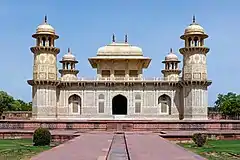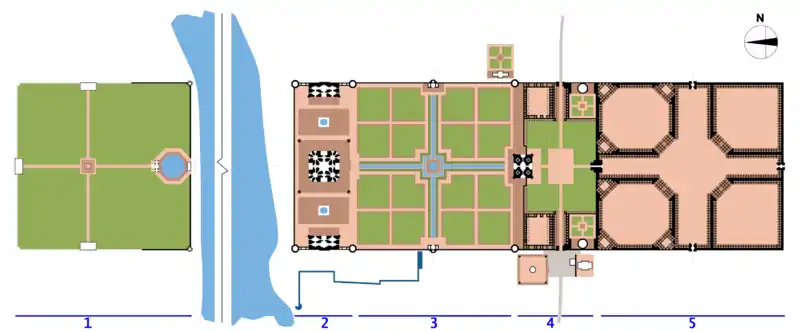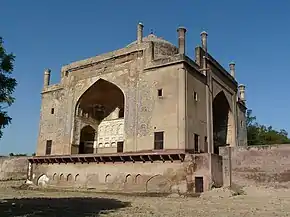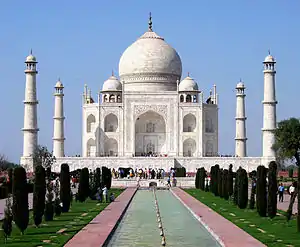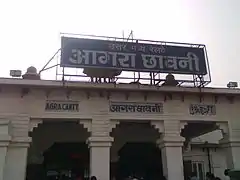Agra
Agra (/ˈɑːɡrə/, Hindustani: [ˈaːgraː] (![]() listen)) is a city on the banks of the Yamuna river in the Agra district of the Indian state of Uttar Pradesh.[12] It is 206 kilometres (128 mi) south of the national capital New Delhi. Agra is the fourth-most populous city in Uttar Pradesh and 24th in India.[13]
listen)) is a city on the banks of the Yamuna river in the Agra district of the Indian state of Uttar Pradesh.[12] It is 206 kilometres (128 mi) south of the national capital New Delhi. Agra is the fourth-most populous city in Uttar Pradesh and 24th in India.[13]
Agra | |
|---|---|
 .jpg.webp)  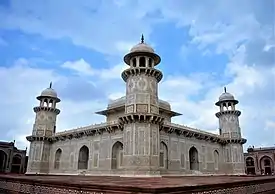 From top: The Taj Mahal, Shivaji monument in front of Agra Fort, Tomb of Akbar the Great, Tomb of I'timād-ud-Daulah. | |
| Nickname(s): The Taj City (Taj Nagari) | |
 Agra 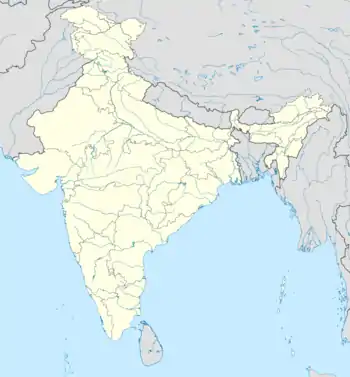 Agra 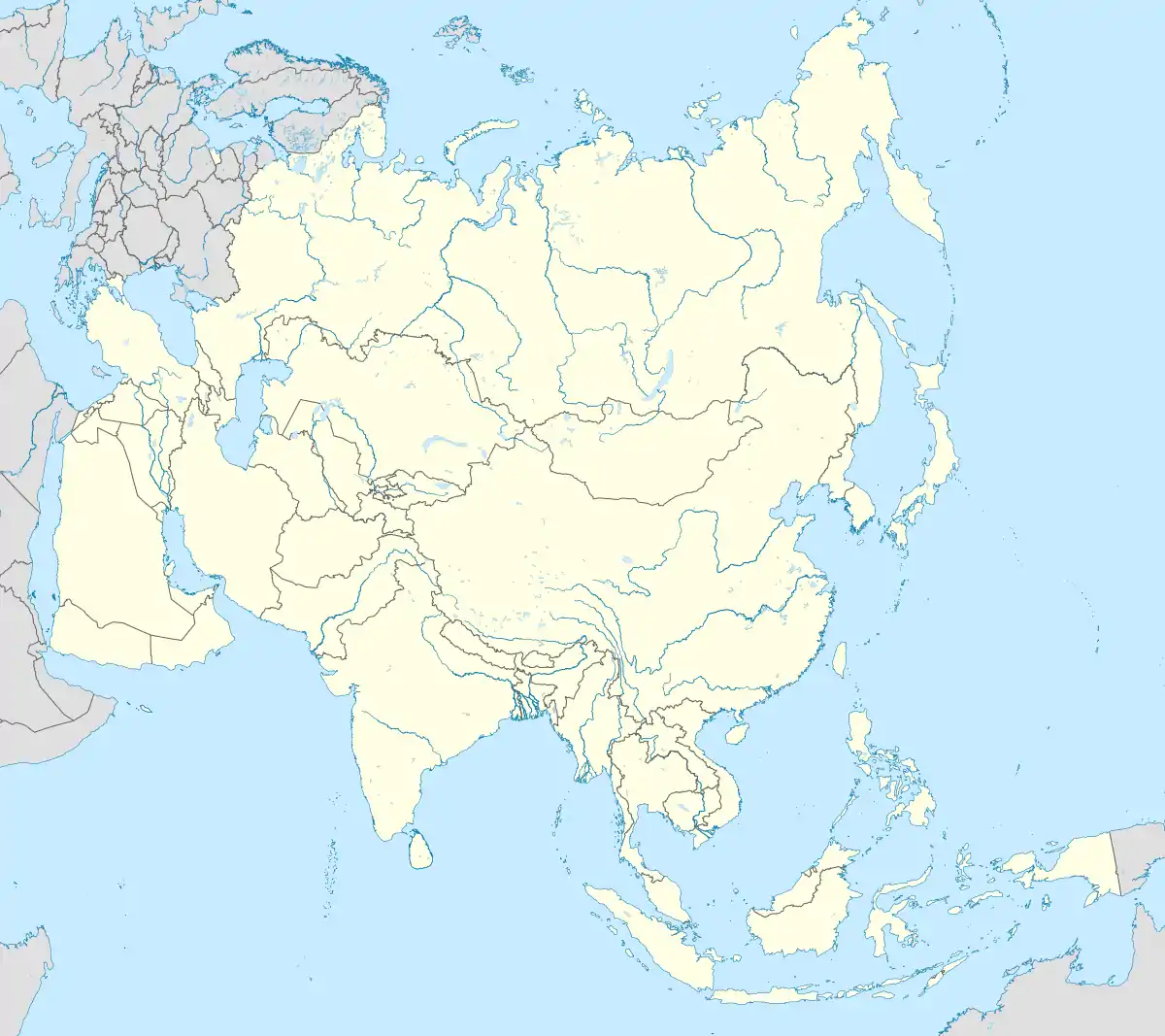 Agra | |
| Coordinates: 27.18°N 78.02°E | |
| Country | |
| State | Uttar Pradesh |
| Division | Agra |
| District | Agra |
| Government | |
| • Type | Municipal Corporation |
| • Body | Agra Municipal Corporation |
| • Mayor[2] | Naveen Jain (BJP) |
| • Municipal commissioner | Nikhil Tikaram Funde[3] |
| Area | |
| • Metropolis[5] | 121 km2 (47 sq mi) |
| Elevation | 170 m (560 ft) |
| Population (2011)[7] | |
| • Metropolis[8] | 1,585,704 |
| • Rank | 23rd |
| • Metro | 1,760,285 |
| Language | |
| • Official | Hindi[10] |
| • Additional official | Urdu[10] |
| • Regional | Braj Bhasha[11] |
| Time zone | UTC+5:30 (IST) |
| Telephone code | 0562 |
| Vehicle registration | UP-80 |
| Sex ratio | 875 ♀ / 1000 ♂ |
| Literacy | 73.11% |
| Website | Official District Website |
Sikandar Lodi was the first ruler of the Delhi Sultanate to move his capital from Delhi to Agra in 1504, and so he is regarded as being the founder of Agra. Sikandar Lodi's son, Ibrahim Lodi, was defeated at the Battle of Panipat in 1526 by Babur, which marked the beginning of Mughal Empire.[14] In a brief interruption in Mughal rule between 1540 and 1556, Sher Shah Suri, established the short lived Sur Empire. Agra was the capital of the Mughal Empire from 1556 to 1648, under the Mughal Emperors Akbar, Jahangir and Shah Jahan, after which Shah Jahan shifted the capital to Delhi. The Mughal Empire saw the building of many monuments, especially Taj Mahal. The city was later taken by the Jats and then Marathas and later still fell to the British Raj.
Agra is a major tourist destination because of its many Mughal-era buildings, most notably the Taj Mahal, Agra Fort and Fatehpur Sikri, all of which are UNESCO World Heritage Sites.[12] Agra is included on the Golden Triangle tourist circuit, along with Delhi and Jaipur; and the Uttar Pradesh Heritage Arc, a tourist circuit of Uttar Pradesh, along with Lucknow and Varanasi. Agra is in the Braj cultural region.
Etymology
The name Agra is explained by three different derivations. The most accepted one is that it had its origin from the Hindi word agar meaning salt-pan, a name which was given to it because the soil in the region is brackish and salt used to be made here once by evaporation. Others derive it from Hindu mythology claiming that the Sanskrit word agra (अग्र) which means the first of the many groves and little forests where Krishna frolicked with the gopis of Vrindavan. Another version is that when Sikander Lodi was sailing down the Yamuna in his royal yacht he asked his steersman to point out a site that was fit for a building a city. Out of the many mounds all around, the steersman pointed to the one directly ahead, supposedly using the Sanskrit word agra (अग्र, 'front'), to express what he meant. Sikander Lodi selected the site and named it Agra. However, there is an improbability underlying this story, it being that common people, specially during the age of the Lodis did not speak in Sanskrit.[15][16]
History
Pre-Mughal era
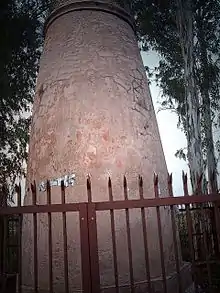
The history of the city before the Afghan invasions in the 11th century is unclear. The history from the Afghan invasions to the Mughal times, though tolerably well documented, has been described as being uneventful.[16] A 17th century chronicler referred to Agra before Sikandar Lodi's reign (1488–1517) as an old settlement which was merely a village, whose degradation in status was a result of the destruction and pillaging done by Mahmud of Ghazni.[17] The 11th-century Persian poet Masud Sa'd Salman claims to have witnessed Mahmud's assault of Agra, adding that Raja Jaypal, the then ruler of the city, surrendered after seeing a nightmare. Mahmud however proceeded to pillage the city.[18] Sultan Sikandar Lodi, the Muslim ruler of the Delhi Sultanate, shifted his capital to Agra in the year 1504, and is thus regarded as the founder of Agra. Before this, it was under the lordship of Bayana, a city in present-day Rajasthan (Bharatpur district)[19][20] After the Sultan's death in 1517, the city passed on to his son, Sultan Ibrahim Lodi. He ruled his sultanate from Agra until he was defeated and killed by Mughal Emperor Babur in the First battle of Panipat, fought in 1526.
Mughal era
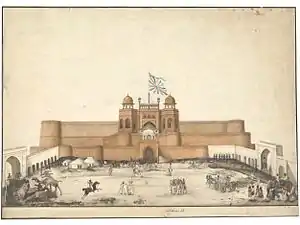
The golden age of the city began with the Mughals. Previously known as Akbarabad, Agra was the capital of the Mughal Empire under the Mughal Emperors Akbar, Jahangir and Shah Jahan. Babur, the founder of the Mughal dynasty, laid out the first formal Persian garden, Aram Bagh (or Garden of Relaxation) on the banks of the river Yamuna. In a brief interruption in Mughal rule between 1540 and 1556, Sher Shah Suri, established the short lived Sur Empire, and the region was eventually reconquered by Akbar in the Second Battle of Panipat in 1556.
Akbar the Great made it the eponymous seat of one of his original twelve subahs (imperial top-level provinces), bordering (Old) Delhi, Awadh (Oudh), Allahabad, Malwa and Ajmer subahs. Since Akbarabad was one of the most important cities in India under the Mughals, it witnessed a lot of building activity. Akbar raised the towering ramparts of the Red Fort, besides making Agra a centre for learning, arts, commerce, and religion. Akbar also built a new capital city of Fatehpur Sikri, around 35 km from Akbarabad (Agra). The new capital city was later abandoned.[21]
Akbar's successor Jahangir had a love of flora and fauna and laid many gardens inside the Red Fort.[22] Shah Jahan, known for his keen interest in architecture, gave Akbarabad (Agra) its most prized monument, the Taj Mahal. Built in loving memory of his wife Mumtaz Mahal, the mausoleum was completed in 1653.
Shah Jahan later shifted the capital to Shahjahanabad (now known as Delhi) in the year 1648,[23] but his son Aurangzeb moved the capital back to Akbarabad, usurping his father and imprisoning him in Agra Fort.
Later periods
The decline of the Mughal empire caused the emergence of several regional kingdoms, and control of the city feel successively to the Jats, the Marathas, the Mughal, the ruler of Gwalior, and finally the British East India Company. The Jats of Bharatpur, waged many wars against the Mughal Delhi and in the 17th and 18th century carried out numerous campaigns in Mughal territories including Agra.[24] After the decline of the Mughal Empire, the city came under the influence of another post-Mughal Empire power, the Marathas and was renamed Agra, before falling into the hands of the British East India Company in 1803.[25]
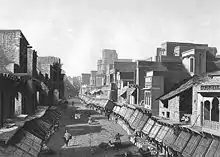
.jpg.webp)
In the years 1835–1836, Agra was the capital of the short-lived Presidency of Agra, administered by a Governor.[26][27] It was the capital of Agra(later renamed North Western Province)Province from 1834 to 1868[28][29][30] and was one of the centres of the Indian rebellion of 1857.[31] Meanwhile, it was witness to the Agra famine of 1837–38,[32] which caused widespread loss of human life as well as livestock, and came to remembered in folk memory as chauranvee, (Hindi, literally, "of ninety four,") for the year 1894 in the Samvat calendar corresponding to the year 1838 CE.[33]
During the Indian rebellion of 1857, when East India Company rule across many parts of India was threatened, the news of the mutiny at Meerut reached Agra on 14 May. On 30 May some companies of the 44th and 67th Native Infantry sent to Mathura to bring in the treasury mutinied and carried off the treasury to the rebels in Delhi. With the fear of the rebellion spreading to Agra as well, the rest of these native infantry battalions, which were part of the garrison at Agra, were successfully disarmed by the British on 31 May.[34]
However, when the Gwalior contingent mutinied on 15 June, all other native units followed. On 2 July the rebel force of the Nimach and Nasirabad contingents reached Fatehpur Sikri. Fearing advance of the mutineers to Agra, some 6000 Europeans and associated people moved into the Agra Fort for safety on 3 July. On 5 July, the British force stationed there attempted to attack an approaching force of Mutineers, but was defeated, and the British retreated back into the fort. The Lieutenant-Governor, J.R. Colvin, died there, and was later buried in front of the Diwan-i-am.[35] The mutineers, however, moved over to Delhi, it being a more important attraction for the rebels. Despite an uprising by a mob and extreme disorder in the city, the British managed to restore partial order by 8 July.[16]
Delhi, in turn, fell to the British in September, following which, an infantry brigade led by Brigadier Greathed arrived in Agra on 11 October without any opposition from rebels. But shortly after their arrival another force of mutineers attacked the brigade by surprise, but was defeated and routed. This minor victory for the British was named the Battle of Agra.[36]
"Those dreadful-looking men must be Afghans"
— an English lady in Agra, who mistook the English infantrymen of Greathed's Brigade as Afghans, seeing their ragged and weary appearance after months of battles with the rebels, from Battles of the Indian mutiny, Michael Edwardes, pp. 52
It is to be said that, the uprising in Agra was relatively minor compared to Delhi, Jhansi, Meerut and other major rebellious cities and regions.[35] After this British rule was again secured, and the British Raj ruled the city till the independence of India in 1947.[37] The capital of the North Western Provinces was shifted from Agra to Allahabad in 1868.[29] Gradually, Agra lost its significance, which it once enjoyed during the Mughal Era.
But in the economy of the administration of British India Agra is nothing more than a district town; its size, proportions and manifold activities have come down to its present requirements, and continued life in this city does not come above the average of that monotonous muffasil life in India which has been so often and so vividly described by many gifted Anglo-Indian writers. Agra has become of late years a large railway centre, and its commercial prosperity seems to be reviving.
— Agra by 1892, as described by S.C. Mukerji, Traveller's Guide to Agra, pp 55-56
Agra's role in the Indian Independence movement is not well documented.[38] However, in the years between the mutiny and independence Agra was a major centre of Hindi and Urdu journalism. Paliwal park(formerly Hewitt park) in Agra is named after S.K.D Paliwal,[39] who brought out the Hindi daily Sainik.[40]
Post Independence and Mughal legacy
Post India's independence, Agra has been a part of Uttar Pradesh and has gradually developed into an industrial city, with a significant contribution to Uttar Pradesh's economy. The city is now a popular tourist destination and hosts tourists from across the world. The Taj Mahal and Agra Fort received UNESCO World Heritage Sites status in 1983.[42][43] The Taj Mahal witnesses tourists, photographers, historians and archaeologists in massive numbers all around the year.
The Taj Mahal has become a symbol of India and its soft power.[44][45] Post Independence, Taj Mahal has been visited by world leaders like US Presidents Dwight D. Eisenhower (1959), Bill Clinton (2000), and Donald Trump (2020). Queen Elizabeth II of the United Kingdom had visited Taj Mahal in 1961 on her India visit. Taj Mahal has also been visited by Russian President Vladimir Putin (1999), Chinese President Hu Jintao (2006), Israeli Prime Minister Benjamin Netanyahu (2018) and Canadian Prime Minister Justin Trudeau (2018).[46]
Agra is the birthplace of the now extinct religion known as Din-i-Ilahi, which was founded by Akbar[47] and also of the Radhaswami Faith, which has around two million followers worldwide.
Geography and climate
Geography
The region around Agra consists almost entirely of a level plain, with hills in the extreme southwest. The rivers in the region include Yamuna and Chambal. The region is also watered by the Agra Canal. Millet, barley, wheat and cotton are among the crops grown. Both Rabi and Kharif crops are cultivated. The deserted city of Fatehpur Sikri is about 40 km southwest of Agra.[48] The sand stone hills near Fatehpur Sikri and on the south-eastern borders of the district are offshoots from the Vindhya range of Central India.[49] Agra is about 210 km away from the National capital of New Delhi(via Yamuna Expressway),[50] about 336 km from state capital Lucknow(via Agra-Lucknow Expressway),[51] and about 227 km from Kanpur(via Agra-Lucknow Expressway).[52] The city has an average elevation of 170 metres above sea level.[6]
Climate
Broadly speaking, the climate of Agra is classified as BSh by the Köppen-Geiger climate classification system.[53] This is the tropical and subtropical steppe climate, major climate type of the Köppen classification that occurs primarily on the periphery of the true deserts in low-latitude semiarid steppe regions. This climate type forms the transition between the desert climate(BW), and the more humid subtropical and tropical climates.[54][55]
The city features mild winters, hot and dry summers and a monsoon season. The Agra district, from its proximity to the sandy Thar desert to the west, is relatively dry, and has greater extremes of temperature than districts further east. The hot west wind, Loo blows mainly during April, May, and June with great force and can cause fatal heatstrokes.[56] The monsoon rains usually begin in the first week in July; and generally end in mid-September. However, the monsoons, though substantial in Agra, are not quite as heavy as the monsoon in other parts of India. The weather grows cold again by the middle of October.[16][57] The region around Agra, the northwest Indo-Gangetic plain is prone to extreme fog in the winter months, which is caused due to natural factors like low winds, low temperatures, availability of moisture apart from air pollution.[58][59] This phenomenon often leads to big delays and sometimes cancellation of trains due to poor visibility. Agra has high levels of air pollution and one of the worst AQIs in India. In a study conducted by WHO using data from years 2010–2016, Agra ranked as the 8th most polluted city in India, along with other nearby cities including Delhi, Kanpur and Faridabad.[60]
| Climate data for Agra, India (1981–2010, extremes 1901–2002) | |||||||||||||
|---|---|---|---|---|---|---|---|---|---|---|---|---|---|
| Month | Jan | Feb | Mar | Apr | May | Jun | Jul | Aug | Sep | Oct | Nov | Dec | Year |
| Record high °C (°F) | 33.0 (91.4) |
35.6 (96.1) |
42.8 (109.0) |
46.5 (115.7) |
48.6 (119.5) |
48.5 (119.3) |
46.5 (115.7) |
43.0 (109.4) |
41.4 (106.5) |
41.1 (106.0) |
36.1 (97.0) |
31.0 (87.8) |
48.6 (119.5) |
| Average high °C (°F) | 22.7 (72.9) |
26.0 (78.8) |
32.1 (89.8) |
38.1 (100.6) |
41.9 (107.4) |
41.5 (106.7) |
36.0 (96.8) |
33.7 (92.7) |
34.5 (94.1) |
34.5 (94.1) |
29.7 (85.5) |
24.5 (76.1) |
32.9 (91.2) |
| Average low °C (°F) | 7.5 (45.5) |
9.9 (49.8) |
14.4 (57.9) |
20.0 (68.0) |
24.6 (76.3) |
26.3 (79.3) |
25.0 (77.0) |
23.8 (74.8) |
22.8 (73.0) |
18.0 (64.4) |
12.4 (54.3) |
7.8 (46.0) |
17.7 (63.9) |
| Record low °C (°F) | −2.2 (28.0) |
−1.7 (28.9) |
5.6 (42.1) |
10.0 (50.0) |
14.0 (57.2) |
12.0 (53.6) |
14.5 (58.1) |
12.0 (53.6) |
13.0 (55.4) |
9.4 (48.9) |
2.8 (37.0) |
−0.6 (30.9) |
−2.2 (28.0) |
| Average rainfall mm (inches) | 12.4 (0.49) |
12.1 (0.48) |
8.8 (0.35) |
12.3 (0.48) |
22.6 (0.89) |
81.7 (3.22) |
214.9 (8.46) |
230.2 (9.06) |
129.6 (5.10) |
29.4 (1.16) |
3.4 (0.13) |
3.5 (0.14) |
760.7 (29.95) |
| Average rainy days | 1.3 | 1.0 | 1.2 | 0.9 | 2.0 | 3.2 | 10.4 | 10.7 | 8.0 | 1.4 | 0.4 | 0.4 | 39.0 |
| Average relative humidity (%) (at 17:30 IST) | 58 | 47 | 39 | 35 | 35 | 40 | 66 | 73 | 63 | 49 | 52 | 58 | 51 |
| Source: India Meteorological Department[61][62] | |||||||||||||
Environment
The Taj Mahal has faced significant damage due to air pollution and sewage discharge into the nearby Yamuna river.[63] The white-marble Taj Mahal is turning yellow and green because of filthy air in the world's eighth-most polluted city.[64] The Taj Mahal flanks the garbage-strewn Yamuna river and is often enveloped by dust and smog from smokestacks and vehicles. Agra has also been witnessing a sharp drop in the tourist footfall from 2017 due to the poor air quality index (AQI) levels.[65]
The Yamuna River is one of the most polluted rivers in the world.[66]
Less than 7% of the Agra district is under forest cover.[67] The only major wildlife sanctuary near Agra is Keetham Lake, also known as Sur Sarovar Bird Sanctuary. The lake has nearly two dozen varieties of migratory and resident birds.[68] Within the Sur Sarovar Bird Sanctuary is the Agra Bear Rescue Facility, which is India's first sanctuary for 'dancing' bears. Operated by Wildlife SOS, Free the Bears Fund and others, the facility has rehabilitate over 620 sloth bears, which were exploited by a nomadic tribe known as the Kalandars as 'dancing bears', despite the practice being illegal since 1972.[69][70]
Demographics
| Population growth | |||
|---|---|---|---|
| Census | Population | %± | |
| 1871 | 142,700 | — | |
| 1881 | 160,200 | 12.3% | |
| 1891 | 168,700 | 5.3% | |
| 1901 | 188,300 | 11.6% | |
| 1911 | 185,400 | −1.5% | |
| 1921 | 185,500 | 0.1% | |
| 1931 | 125,300 | −32.5% | |
| 1941 | 284,100 | 126.7% | |
| 1951 | 375,700 | 32.2% | |
| 1961 | 462,000 | 23.0% | |
| 1971 | 594,900 | 28.8% | |
| 1981 | 723,700 | 21.7% | |
| 1991 | 891,800 | 23.2% | |
| 2001 | 1,275,000 | 43.0% | |
| 2011 | 1,585,000 | 24.3% | |
| Figures rounded off. Source:[71] | |||
As of 2011 India census,[7][72] Agra city has a population of 1,585,704, while the population of Agra cantonment is 53,053. The urban agglomeration of Agra has a population of 1,760,285.[72] Males constitute 53% of the population and females 47%. Agra city has an average literacy rate of 73%, below the national average of 74%.[72] Literacy rate of males is considerably higher than that of women. The sex ratio in the city was 875 females per thousand males while child sex ratio stood at 857.[72] Agra district literacy rate is 62.56%.[73]
According to the 2011 census, Agra district has a population of 4,380,793,[74] roughly equal to the nation of Moldova[75] or the US state of Kentucky.[76] This gives it a ranking of 41st in India (out of a total of 640).[74] The district has a population density of 1,084 inhabitants per square kilometre (2,810/sq mi) .[74] 52.5% of Agra's population is in the 15–59 years age category. Around 11% of the population is under 6 years of age.
Hindus are 88.8% while Muslims are 9.3% of the population in Agra district.[77] Hinduism, Islam and Jainism are the major religions in Agra city with 80.7%, 15.4% and 1.0% of the population adhering to them; others are 2.9%. The Catholic minority is served by its own Metropolitan Archdiocese of Agra.
Administration and politics
General administration
| Key posts of local administration | Person |
|---|---|
| Mayor (elected post) | Naveen Kumar Jain (BJP)[3] |
| Municipal commissioner | Nikhil Tikaram Funde[3] |
| Vice-chairman of ADA | Devendra Kumar Singh Kushwaha[78] |
| District and divisional administration | Person |
| Divisional commissioner | Anil Kumar[79][80] |
| District magistrate and collector | Prabhu N Singh[81] |
| Police administration | Person |
| Senior superintendent of police (SSP) | Babloo Kumar[82] |
| ADG, Agra Zone | Ajay Anand[83] |
| IG, Agra Range | A. Satish Ganesh[84] |
Agra division which consists of four districts, and is headed by the divisional commissioner of Agra, who is an IAS officer, the commissioner is the head of local government institutions (including municipal corporations) in the division, is in charge of infrastructure development in his division, and is also responsible for maintaining law and order in the division.[85][86][87][88] The district magistrate of Agra reports to the divisional commissioner.
Agra district administration is headed by the district magistrate and collector (DM) of Agra, who is an IAS officer. The DM is in charge of property records and revenue collection for the central government and oversees the elections held in the city. The DM is also responsible for maintaining law and order in the city.[85][89][90][91] The DM is assisted by a chief development officer; six additional district magistrates for finance/revenue, city, administration, land acquisition, civil supply, and protocol; one city magistrate; and three additional city magistrates.[92]
Police administration
Agra district comes under the Agra Police Zone and Agra Police Range, Agra Zone is headed by an additional director general (ADG)-ranked Indian Police Service (IPS) officer, and the Agra Range is headed by a deputy inspector general (DIG)-ranked IPS officer.
The district police is headed by a senior superintendent of police (SSP), who is an IPS officer, and is assisted by six superintendents of police or additional superintendents of police for city, east, west, crime, traffic, and protocol, either from the IPS or the Provincial Police Service.[82] Each of the several police circles is headed by a circle officer in the rank of deputy superintendent of police.[82]
Infrastructure and civic administration
The development of infrastructure in the city is overseen by Agra Development Authority (ADA), which comes under the Department of Housing and Urban Planning of the Uttar Pradesh government. The Divisional Commissioner of Agra acts as the ex-officio Chairman of ADA, whereas a vice-chairman, a government-appointed IAS officer, looks after the daily matters of the authority.[93]
The Agra Municipal Corporation oversees the city's civic infrastructure. The head of the corporation is the mayor, but the executive and administration of the corporation is the responsibility of the municipal commissioner, who is an Uttar Pradesh government-appointed Provincial Civil Service officer of high seniority. Agra Municipal Corporation is divided into 100 wards[94] for the purpose of local administration.
Politics
Agra district has two Lok Sabha constituencies, Agra and Fatehpur Sikri, and nine Uttar Pradesh Vidhan Sabha (Uttar Pradesh Legislative Assembly) constituencies.[96] The MP for Agra constituency is SP Singh Baghel,[97] from Bharatiya Janata Party.
Utilities
The electricity power distribution and bill collection in Agra is the sole responsibility of Torrent Power, a private sector company. The control of power distribution in Agra was handed over to Torrent Power from the state-owned UP Power Corporation Ltd in 2010, in an effort to move towards power reforms and cutting the massive distribution losses in the state. This was the first time power distribution was privatised in Uttar Pradesh, except for Noida-Greater Noida falling under the NCR.[98][99]
Agra has three primary sources for municipal water supply: water treatment plants at Sikandra and Jeoni Mandi, and groundwater using tubewells.[100] Since a large portion of the water demand is fulfilled from the Yamuna river, which is a highly polluted river, water quality in Agra is usually poor, with unhealthy levels of chlorine required for purification. The city's groundwater is also unfit for drinking, and is saline and high in fluoride content. Both sources breach CPCB standards.[101] To provide the city with adequate water supply, the Gangajal pipeline project has been initiated.[102] It includes a 130 km long pipeline laid to bring Ganga water from Bulandshahr's Upper Ganga canal to Agra. The project has been launched,[103] but has faced criticism due to frequent pipeline leakages.[104][105][106]
Though most of the city uses cylinders for cooking gas, piped natural gas is also available in select localities, including Kamla Nagar and others. The service is provided by Green Gas Limited.[107][108]
Economy
Due to the presence of the Taj Mahal and other historic monuments, Agra has a booming tourism industry as well as royal crafts like Pietra Dura, marble inlay and carpets.[109]
40% of the population depends largely on agriculture, and others on the leather and footwear business and iron foundries. Agra was the second most self-employed in India in 2007, behind Varanasi, followed by Bhopal, Indore and Patna. According to the National Sample Survey Organization, in 1999–2000, 431 of every 1,000 employed males were self-employed in the city, which grew to 603 per 1,000 in 2004–05.[110]
Tourism has a significant role in the economy of Agra, with upwards of 9.5 million tourists visiting Agra and surrounding monuments in 2019.[111] The city is home to Asia's largest spa called Kaya Kalp – The Royal Spa, at the ITC Hotel Mughal in Agra.[112][113] Other hotels include Taj Hotel and Convention Centre.[114]
Sanjay Place is the trade centre of Agra. There are about 12 major and medium scale industries, producing electrical goods, pipes, leather goods etc. There are about 7,200 small scale industrial units. Above 1.5 lakh pairs of shoes per day are manufactured in agra by the various footwear units.[115] Agra city is also known for its leather goods, the oldest and famous leather firm Taj Leather World is in Sadar bazar. The carpets, handicrafts, zari and zardozi (embroidery work), marble and stone carving and inlay work.[116][117]
As of August 2020, Industrial activity in Agra has been affected as a result of the restrictions imposed due to the COVID-19 pandemic that has forced people to remain confined to their homes. The sectors worst-hit are the iron foundries, tourism, leather shoe industry in Agra.[118] It is estimated that the loss in the tourism industry due to COVID-19 restrictions is approximately ₹ 2,200 crores.[119]
Developmental indicators
Agra amassed a GDP of 40,210 crores as per the data released by UP Government for the year 2018–19, thus the 3rd rank in the state.[120]
In the Swachh Survekshan 2020, Agra ranked 16th nation-wide, and 2nd in the state after Lucknow, which was a big jump after 86th in 2019, 102nd in 2018, and 263th in 2017.[121][122] In the Smart city Rankings, which are pan-India rankings for 100 cities which is released by the Ministry of Housing and Urban Affairs based on the progress/completion rate of Smart City projects, Agra ranked 1st, based on the rankings released based on work done by department concerned under the Smart City project from 1 October 2019, to 1 March 2020.[123][124]
Monumental Mughal legacy
Taj Mahal
The Taj Mahal rises above the banks of the river like a solitary tear suspended on the cheek of time.
— Rabindranath Tagore, (translated by Kshitish Roy) from One Hundred and One Poems by Rabindranath Tagore (pp. 95-96)
The mausoleum of Shah Jahan's favourite wife, Mumtaz Mahal, Taj Mahal is one of the New Seven Wonders of the world,[125] and one of the three World Heritage Sites in Agra.[126] The Taj Mahal is the most visited tourist spot in the India, attracting nearly 6.9 million visitors in 2018–19.[127]
The Taj Mahal is distinguished as the finest example of Mughal architecture, a blend of Indian, Persian, and Islamic styles. Agra is commonly identified as the "City of Taj".[128] Completed in 1653, the Taj Mahal was built by the Mughal emperor Shah Jahan as the final resting place for his favourite wife, Mumtaz Mahal. Finished in marble, it is one of India's many beautiful monuments and is set amidst landscaped gardens. Designed by the Persian architect, Ustad Ahmad Lahori, the Taj Mahal is on the south bank of the Yamuna River. It can be observed from Agra Fort from where Emperor Shah Jahan gazed at it for the last eight years of his life, a prisoner of his son Aurangzeb. Verses of the Quran are inscribed on it and at the top of the gate are 22 small domes, signifying the number of years the monument took to build. The Taj Mahal was built on a marble platform that stands above a sandstone one. The most elegant and largest dome of the Taj Mahal has a diameter of 60 feet (18 m), and has a height of 80 feet (24 m); directly under this dome is the tomb of Mumtaz Mahal. Shah Jahan's tomb was erected next to hers by his son Aurangzeb. The interiors are decorated with fine Pietra dura inlay work, incorporating semi-precious stones.
However, air pollution caused by emissions from foundries and other nearby factories and exhaust from motor vehicles has damaged the Taj, notably its marble facade.[129] A number of measures have been taken to reduce the threat to the monument, among them the closing of some foundries and the installation of pollution-control equipment at others, the creation of a parkland buffer zone around the complex, and the banning of nearby vehicular traffic, and more recently, use of 'mud pack' therapy.[130] Perhaps most importantly, the 10,400 km2 (4,000 sq mi) Taj Trapezium Zone has been created around the Taj Mahal and other nearby monuments where strict pollution restrictions are in place on industries, following a 1996 Supreme Court of India ruling.[131]

Agra Fort
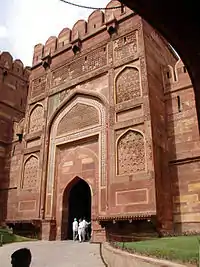
Agra Fort (sometimes called the Red Fort), was commissioned by the conquering Mughal Emperor Akbar the Great in 1565, and is another of Agra's World Heritage Sites. A stone tablet at the gate of the Fort states that it had been built before 1000 but was later renovated by Akbar. The red sandstone fort was converted into a palace during Shah Jahan's reign, and reworked extensively with marble and pietra dura inlay. Notable buildings in the fort include the Pearl Mosque or Moti Masjid, the Diwan-i-Am and Diwan-i-Khas (halls of public and private audience), Jahangir's Palace, Khas Mahal, Shish Mahal (mirrored palace), and the Musamman Burj.[132]
The forbidding exteriors of this fort conceal an inner paradise. The fort is crescent-shaped, flattened on the east with a long, nearly straight wall facing the river. It has a total perimeter of 2.4 kilometres (1.5 mi), and is ringed by double castellated ramparts of red sandstone punctuated at regular intervals by bastions. A moat 9 metres (30 ft) wide and 10 metres (33 ft) deep surrounds the outer wall.
Shivaji visited the Agra Fort, as a result of the conditions of the Treaty of Purandar entered into with Mirzā Rājā Jaisingh to meet Aurangzeb in the Diwan-i-Khas (Special Audience Chamber). In the audience, he was deliberately placed behind men of lower rank. An insulted Shivaji stormed out of the imperial audience and was confined to Jai Sing's quarters on 12 May 1666. Fearing the dungeons and execution he escaped on 17–19 August 1666.[133][134][135]
The fort is a typical example of Mughal architecture, effectively showing how the North Indian style of fort construction differed from that of the South. In the South, the majority of forts were built on the seabed like the one at Bekal in Kerala.[136]
Itmad-Ud-Daulah's Tomb
The Empress Nur Jahan built Itmad-Ud-Daulah's Tomb, sometimes called the "Baby Taj", for her father, Mirza Ghiyas Beg, the Chief Minister of the Emperor Jahangir. Located on the left bank of the Yamuna river, the mausoleum is set in a large cruciform garden, criss-crossed by water courses and walkways. The area of the mausoleum itself is about 23 m2 (250 sq ft), and is built on a base that is about 50 m2 (540 sq ft) and about one metre (3.3 feet) high. On each corner are hexagonal towers, about thirteen metres (43 feet) tall. Small in comparison to many other Mughal-era tombs, it is sometimes described as a jewel box. Its garden layout and use of white marble, pietra dura, inlay designs and latticework presage many elements of the Taj Mahal.
The walls are white marble from Rajasthan encrusted with semi-precious stone decorations – cornelian, jasper, lapis lazuli, onyx, and topaz in images of cypress trees and wine bottles, or more elaborate decorations like cut fruit or vases containing bouquets. Light penetrates to the interior through delicate Jali screens of intricately carved white marble.
Many of Nur Jahan's relatives are interred in the mausoleum. The only asymmetrical element of the entire complex are the tombs of her father and mother, which have been set side-by-side, a formation replicated in the Taj Mahal.
Akbar's Tomb, Sikandra
Sikandra, the last resting place of the Mughal Emperor Akbar the Great, is on the Delhi-Agra Highway, about 13 kilometres (8.1 miles) from the Agra Fort.[137] The four-storied tomb combines both marble and sandstone in its exterior. The construction of Sikandra was commenced in Akbar's reign, and was completed by his heir and son Jahangir in 1613. The tomb with is set amidst a large garden, and is enclosed by four battlemented walls, each with a large gateway. The 99 names of Allah have been inscribed on the tomb. The tomb has seen some damage to its minarets and other aspects, which was inflicted by the Jats of Bharatpur.[138] The vast gardens around Sikandra are inhabited by several Blackbucks, which are in the process of being shifted to the Etawah Safari Park.[139]
Other places of Interest
Agra also has several other places of interest, most of them from its Mughal past. They include the Jama Masjid, Chini Ka Rauza, Aram Bagh, Mariam's Tomb, Mehtab Bagh among others. The Jama Masjid is a large mosque attributed to Shah Jahan's daughter Jahanara Begum, built in 1648, notable for its unusual dome and absence of minarets. The Chini Ka Rauza, notable for its Persian influenced dome of blue glazed tiles, is dedicated to the prime minister of Shah Jahan, Afzal Khan.[140] The Aram Bagh, commonly known as Ram Bagh today, is one of the oldest Mughal garden in India, and was built by the Mughal emperor Babur in 1528 on the bank of the Yamuna.[141] It lies about 2.3 km (1 mi) north of the Taj Mahal. The original name of the gardens was Aram Bagh, or 'Garden of Relaxation', and this was where Babur used to spend his leisure time. Mariams Tomb, is the tomb of Mariam, the wife of Emperor Akbar.[142] The tomb is within the compound of the Christian Missionary Society. The Mehtab Bagh, or 'Moonlight Garden', is on the opposite bank of the River Yamuna from the Taj Mahal. Agra also has a nearby bird sanctuary, Keetham Lake. Also known as Sur Sarovar Bird Sanctuary, it is situated within the Surdas Reserved Forest. The lake has nearly two dozen varieties of migratory and resident birds.[68]
Culture
Cuisine
Agra's cuisine is derived from its Mughal past. Petha, a sweet made using ash gourd, is one of the famous dishes of Agra, and is available in many varieties. It is said to have originated from Shah Jahan's royal kitchen. Another dish that is endemic to Agra is Dalmoth, which is a dry snack made with spicy fried lentils (dal), nuts and raisins. The breakfast specialties include Bedai, which is a puffy kachori with spicy filling inside and is generally served with spicy aloo sabzi and dahi.[143][41]
Taj Mahotsav
Taj Mahotsav is a cultural festival and craft fair that was started in the year 1992 and has grown since then. The year 2019 was the 28th year of this Mahotsav. The fair is held in a big field in Shilpgram, near the eastern gate of the Taj Mahal. This festival also figures in the calendar of events of the Department of Tourism, Government of India. A large number of Indian and foreign tourists coming to Agra join this festivity. One of the objectives of this craft fair is to provide encouragement to the artisans. It also makes available works of art and craft at reasonable prices that are not inflated by high maintenance cost.[144] The Mahotsav is hosted from 18 to 27 February every year. The theme for the 2020 Taj Mahotsav was Sanskriti ke Rang, Taj ke Sang.[145]
Ram Barat
Ram Barat (Hindi: राम बारात) is a part of Ramlila celebration in Agra. It is one of the biggest annual events in North India. Ram Barat literally means Baraat Marriage procession of Sri Ram. Every year a new locality is chosen in Agra and is elaborately decorated with lights & flowers. The area is given a major facelift befitting the venue for the divine marriage.
Taj Literature Festival
Taj Literature Festival saw stars of the literary world manifest themselves on the earth of Agra. The galaxy included the stalwarts, Muzaffar Ali, Shobha De, Prahlad Kakker and Raghu Rai. The stage shone brilliant and the heritage city breathed life. This festival, an attempt to rejuvenate that aesthetic spirit which is a soul of this historically rich city, Agra. The city that nurtured the likes of Ghalib, Tansen, Surdas, Nazeer and many more.
Kailash Fair
The Kailash Fair is held in the town of Kailash, about 12 km (7 mi) from Agra, in the month of August/September. It is a major fair celebrated in honour of Lord Shiva who is believed to have appeared here in the form of stone Lingam.
Taj Municipal Museum in Paliwal Park
The museum-cum-public library is housed in an old heritage structure, built in 1922 and renovated in the 1940s. Queen Victori's bronze statues are also displayed in this Museum. The other old statues and memories of the Mughal Era are exposed for the attraction of tourists.
Transport
Air
Air India and its subsidiary, Alliance Air, fly to Agra airport. Zoom Air also commences flight operations to Jaisalmer and New Delhi from Agra Airport.[146] Indigo will start flights to Bangalore from 27 March 2020 and direct flights from Lucknow, Varanasi and Bhopal to Agra Airport from 29 March 2020.[147]
Rail

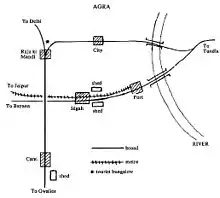
Agra City comes under the jurisdiction Of Agra Division Of North Central Railways Zone of the Indian Railways . Agra is on the Central Train line between Delhi (Station Code: NDLS) and Mumbai (Station Code: CSTM) and between Delhi and Chennai (Station Code: MAS) and many trains like Bhopal Shatabdi, Taj Express, Doon Express, Gatimaan Express, Bhopal Express, Malwa Express, Gondwana Express, Jabalpur - Jammutawi Express, Shreedham Express, Garib Rath, Tamil Nadu Express, Chennai Rajdhani, Agra Mathura Express etc. connect Agra with all major Indian cities like New Delhi, Hyderabad, Mumbai, Kolkata, Chennai, Visakhapatnam, Bengaluru, Pune, Bhopal, Indore, Kanpur, Kochi, Gwalior, Meerut, Saharanpur, Dehradun, Jabalpur, Ujjain, Jaipur, Haridwar, Aligarh, Mathura, Alwar, Lucknow, Thiruvananthapuram etc. every day. Some east-bound trains from Delhi also travel via Agra, so direct connections to points in Eastern India (including Kolkata) are also available. There are close to 20 trains to New Delhi and Gwalior Junction every day, and at least three or four to Bhopal, Indore, Nagpur, Mumbai and Chennai. There are three main railway stations in Agra: Agra Cantt, Raja Ki Mandi, and Agra Fort.
Railway Stations served by the Agra Division, North Central Railways network at Agra are:
Agra-Delhi Semi-High Speed Train – Gatimaan Express
In July 2014, a trial run of a "semi-high speed train" with 10 coaches and 2 generators reached a speed of 160 km/h (99 mph) between New Delhi and Agra. This is of the same class as New Delhi Agra Shatabdi Express, which takes 2 hours to complete its journey. The new semi-high speed train Gatimaan Express that reduces travel time between Delhi and Agra began in April 2016.
Road
.jpg.webp)
Inter-State Bus Terminal (I.S.B.T.), Idgah Bus Stand, Taj Depot and Fort Depot are the major bus stands in Agra, connecting Agra to most of the bigger cities in northern India. It is a major junction of highways with three national highways and two expressways (Yamuna Expressway & Agra Lucknow Expressway) originating from Agra.
- From Delhi: NH 19 (old number: NH 2), a modern divided highway, connects the 200 km (124 mi) distance from Delhi to Agra.
- From Delhi / Noida: Yamuna Expressway, a modern access controlled highway connects the 200 km (124 mi) distance from Delhi to Agra.
- Yamuna Expressway (formerly Taj Expressway) is a six lane, 165 km (103 mi) long, controlled-access expressway, that connects New Delhi with Agra via Greater Noida and Mathura in the Indian state of Uttar Pradesh.
- NH 509 (old number: NH 93) connects Agra to Moradabad via Aligarh.
- Agra Lucknow Expressway is a six lane, 302 km (188 mi) long, controlled-access expressway, that connects Lucknow with Agra via Kannauj and Etawah in the Indian state of Uttar Pradesh.
Bus services are run by the Agra Municipal Corporation. Other para-transit modes include rickshaws. Polluting vehicles are not allowed near the Taj Mahal. Within the city, Mahatma Gandhi Marg is the main artery.
Agra Metro
Rail India Technical and Economic Service (RITES) had proposed 30 stations, 11 underground and 19 elevated, for two corridors of the Metro Rail in the city. The two routes are Sikandra to the Taj Mahal's east gate via Agra Fort and Agra Cantt to Kalindi Vihar. On 24 March 2017, State Chief Minister Yogi Aditya Nath approved the project. In December 2017, the cabinet of the UP Government approved the DPR as per New Metro Policy. Prime Minister Narendra Modi laid the foundation stone of Agra Metro on 8 March 2019.[148]
Education
It was during the advent of the Mughal era that Agra grew as a centre of Islamic education. In the year 1823, Agra College, one of the oldest colleges in India was formed out of a Sanskrit school established by the Scindia rulers. In the British era, Agra became a great centre of Hindi literature with people like Babu Gulab Rai at the helm.
Universities and colleges
Agra University was established on 1 July 1927 and catered to colleges spread across the United Provinces, the Rajputana, the Central Provinces and almost to entire northern India. There are 10 institutes comprising various departments and around 700 Colleges are affiliated to this university. The historic Agra University was later rechristened as Dr. Bhim Rao Ambedkar University by the then Chief Minister of Uttar Pradesh, Mayawati.
- The Institute of Mental Health and Hospital, formerly known as Agra Lunatic Asylum, was established in September 1859 governed by the State of Uttar Pradesh. It is spread over an extensive and beautiful ground of 172.8 acres (69.9 ha) land and is well-known centre for the treatment, training, and research on mental disorders in Northern India. The institute was renamed as Mental Hospital, Agra in 1925. Presently all admissions and discharges are being done under the provisions of Mental Health Act, 1987.
- Central Institute of Hindi, (also known as Kendriya Hindi Sansthan) is an autonomous institute under Ministry of Human Resource Development, Government of India engaged in teaching Hindi as a foreign and second language. Apart from running residential Hindi language courses for foreign students, the institute also conducts regular training programmes for teachers of Hindi belonging to non-Hindi states of India. The institute is situated at a 11 acres (4.5 ha) campus on the outskirts of Agra city. Headquartered in Agra the institute has eight regional centres in Delhi, Hyderabad, Mysore, Shillong, Dimapur, Guwahati, Ahmedabad and Bhubneshwar. The institute is the only government-run institution in India established solely for research and teaching of Hindi as a foreign and second language.
- Sarojini Naidu Medical College, is one of the three oldest medical colleges of India. It is located in Agra, Uttar Pradesh state. It is named after the first lady Governess of Uttar Pradesh, poet and freedom fighter, Bharat Kokila Smt. Sarojini Naidu.
- Agra College, is one of the oldest institutions in India. Pandit Gangadhar Shastri, a noted Sanskrit scholar founded the college in 1823. Till 1883 the institute was a government college and after that, a Board of Trustees and a Committee of Management managed the college. Agra College produced the first graduate in Uttar Pradesh and the first Law graduate to Northern India.
- St. John's College, Agra, is a college established in 1850, now part of the Dr. Bhim Rao Ambedkar University, earlier known as Agra University. It is amongst the oldest and one of the most beautiful Christian colleges in India. The college runs a study centre of Indira Gandhi National Open University, a central university.
- Raja Balwant Singh College, Established in 1885 owes its existence to Raja Balwant Singh Ji of Awagarh who enabled the institution to grow as one of the oldest and biggest colleges of Uttar Pradesh. Raja Balwant Singh College is located at Bichpuri, Agra, Uttar Pradesh, India. The college is affiliated to Uttar Pradesh Technical University, Lucknow, and Dr. B.R. Ambedkar University, Agra.
- Dayalbagh Educational Institute, Radhasoami Satsang Sabha, started the Radhasoami Educational Institute, as a co-educational Middle School, open to all, on 1 January 1917. It became a Degree College in 1947, affiliated to Agra University. In 1975, it formulated a programme of undergraduate studies which received approbation from the Government of Uttar Pradesh and the University Grants Commission, as a result of which in 1981 the Ministry of Education, Government of India, conferred the status of an institution deemed to be a University on the Dayalbagh Educational Institute, to implement the new scheme.
- UEI Global, consecutively ranked among the top management institutes of India by Competition Success Review for the year 2013 and 2012. The college has 12 campuses across India and provides programs in Hotel Management and Business Management.
Media
Agra is home to the Dainik Jagran newspaper, the most read Hindi newspaper in India.[149] Other widely read papers include Amar Ujala, Rajasthan Patrika,Aaj, Hindustan,The Sea Express, "daily Amar Bharti", Deepsheel Bharat, DLA. The English dailies published are The Times of India, Hindustan Times, Economic Times, and The Pioneer. The Urdy dailies published are Prabhanjan Sanket, and Inksaaf. There is also the Hindi and English mixed newspaper tabloid I-NEXT.
| Frequency | Station |
|---|---|
| 90.4 MHz | Agra ki Awaaz |
| 90.8 MHz | Aap ki Awaaz |
| 93.7 MHz | Fever FM |
| 91.9 MHz | Radio City |
| 92.7 MHz | Big 92.7 FM |
| 94.5 MHz | Tadka FM |
| 105.6 MHz | GNOU Gyan Vani |
State-owned All India Radio has a local station in Agra which transmits various programs of mass interest. There are four private FM radio stations, 92.7 BIG FM (Reliance Broadcast Network Limited), 93.7 Fever FM, 94.5 Tadka FM and Radio City 91.9 FM.[150] There is a community Radio Station 90.4 FM.
Notable people
Sister cities
Agra is twinned with:
See also
References
- "Metropolitan Cities of India" (PDF). cpcb.nic.in. Archived from the original (PDF) on 23 September 2015. Retrieved 22 December 2020.
- Lavania, Deepak (2 December 2017). "BJP wins post of Agra mayor for fifth consecutive time". The Times of India. The Times Group. Archived from the original on 23 October 2018. Retrieved 27 May 2018.
- "Agra Municipal Corporation::". www.nagarnigamagra.com. Retrieved 7 September 2020.
- "Agra Nagar Nigam" (PDF). nagarnigamagra.com. Retrieved 21 November 2020.
- "Metropolitan Cities of India" (PDF). cpcb.nic.in. Archived from the original (PDF) on 23 September 2015. Retrieved 22 December 2020.
- "Elevation of Agra - Wolfram|Alpha". www.wolframalpha.com. Retrieved 26 September 2020.
- "Census 2011". The Registrar General & Census Commissioner, India. Retrieved 21 May 2016.
- "Metropolitan Cities of India" (PDF). cpcb.nic.in. Archived from the original (PDF) on 23 September 2015. Retrieved 22 December 2020.
- "Uttar Pradesh (India): State, Major Agglomerations & Cities – Population Statistics, Maps, Charts, Weather and Web Information". citypopulation.de. Archived from the original on 12 November 2017. Retrieved 11 November 2017.
- "52nd Report of the Commissioner for Linguistic Minorities in India" (PDF). nclm.nic.in. Ministry of Minority Affairs. Archived from the original (PDF) on 25 May 2017. Retrieved 7 December 2018.
- "Braj Bhasha". Ethnologue. Retrieved 6 October 2020.
- Centre, UNESCO World Heritage. "Agra Fort". whc.unesco.org. Archived from the original on 17 July 2010. Retrieved 11 November 2017.
- "Cities in India with population more than 100,000". Census2011. Archived from the original on 7 April 2013. Retrieved 10 June 2016.
- "Agra Fort". Archaeological Survey of India. Archived from the original on 3 December 2009. Retrieved 8 November 2009.
- Mukerji, Satya Chandra (1892). The traveller's guide to Agra, containing an account of the past history, the antiquities, and the principal sights of Agra, together with some information about Agra as it is. University of California Libraries. Delhi, Sen & Co. p. 3.
- Govt.of India (1944). Agra Vol Xiv. p. 22.
- Abraham Eraly, The Age of Wrath: A History of the Delhi Sultanate
- Sunil Sharma, Persian Poetry at the Indian Frontier: Masʻŝud Saʻd Salmân of Lahore
- W Haig, The Cambridge History of India, Cambridge University Press, London, p. 242
- "Hardingeâs Imperial Delhi Committee and his Architectural Board", New Delhi: The Last Imperial City, Palgrave Macmillan, 2015, doi:10.1057/9781137469878.0012, ISBN 978-1-137-46987-8
- "16fatahpursikri". www.columbia.edu. Retrieved 14 September 2020.
- Siddiqi, Zeba (2006). "City of Agra under the Mughal from 1526-1707" (PDF). Centre of Advance Study Department of History Augarh Muslim University Aligarh (India): 10, 11.
- Richards, John F. (1995). The Mughal Empire. Cambridge University Press. ISBN 9780521566032.
- The Gazetteer of India: History and culture. Publications Division, Ministry of Information and Broadcasting, India. 1973. p. 348. OCLC 186583361.
- "Agra | India". Encyclopedia Britannica. Retrieved 16 September 2020.
- Imperial Gazetteer of India vol. V. 1908. p. 72.
- Agrawal, Pramod Kumar (16 September 1993). Land Reforms in India: Constitutional and Legal Approach (with Special Reference to Uttar Pradesh). M.D. Publications Pvt. Ltd. ISBN 9788185880099 – via Google Books.
- Imperial Gazetteer of India, vol. V, 1908
- Mukerji, Satya Chandra (1892). The traveller's guide to Agra, containing an account of the past history, the antiquities, and the principal sights of Agra, together with some information about Agra as it is. University of California Libraries. Delhi, Sen & Co. p. 51.
- Ashutosh Joshi (1 January 2008). Town Planning Regeneration of Cities. New India Publishing. p. 237. ISBN 978-8189422820.
- History, Kenneth Pletcher Senior Editor, Geography and (15 August 2010). The Geography of India: Sacred and Historic Places. The Rosen Publishing Group, Inc. p. 95. ISBN 978-1-61530-142-3.
- Girdlestone, C. E. R. (1868). Report on Past Famines in the North-Western Provinces. Government Press, North-Western Provinces. p. 42.
- Sharma, Sanjay (26 July 2016). "The 1837-38 famine in U.P.: Some dimensions of popular action". The Indian Economic & Social History Review. 30 (3): 370. doi:10.1177/001946469303000304. S2CID 143202123.
- Mukerji, Satya Chandra (1892). The traveller's guide to Agra, containing an account of the past history, the antiquities, and the principal sights of Agra, together with some information about Agra as it is. University of California Libraries. Delhi, Sen & Co. p. 45,48.
- "07latermughals". www.columbia.edu. Retrieved 13 September 2020.
- Edwardes, Michael (1963). Battles of the Indian mutiny. pp. 50–53.
- "Agra City" (GIF). Imperial Gazetteer of India (Digital South Asia Library of University of Chicago). 5: 83–84. Archived from the original on 22 May 2010. Retrieved 8 November 2009.
- IANS (14 August 2015). "Agra's crucial role in freedom movement not documented: Historians". Business Standard India. Retrieved 2 October 2020.
- "The heritage of British period statues". The Statesman. 13 June 2019. Retrieved 2 October 2020.
- "History of Hindi Journalism". www.indianfaculty.com. Retrieved 2 October 2020.
- Sharma, Sudhirendar (12 October 2019). "Name, place, confection, thing". The Hindu. ISSN 0971-751X. Retrieved 12 September 2020.
- Centre, UNESCO World Heritage. "Taj Mahal". UNESCO World Heritage Centre. Retrieved 26 September 2020.
- Centre, UNESCO World Heritage. "Agra Fort". UNESCO World Heritage Centre. Retrieved 26 September 2020.
- "India has an edge over China in soft power, divisive politics must not harm it". www.dailyo.in. Retrieved 12 September 2020.
- "Distinguished Lectures Details". www.mea.gov.in. Retrieved 12 September 2020.
- S, Deepika (25 February 2020). "Top world leaders who visited the iconic Taj Mahal". OneIndia. Retrieved 12 September 2020.
- "Dīn-i Ilāhī | Indian religion". Encyclopedia Britannica. Retrieved 12 September 2020.
- History, Kenneth Pletcher Senior Editor, Geography and (15 August 2010). The Geography of India: Sacred and Historic Places. The Rosen Publishing Group, Inc. p. 95. ISBN 978-1-61530-142-3.
- Mukerji, Satya Chandra (1892). The traveller's guide to Agra, containing an account of the past history, the antiquities, and the principal sights of Agra, together with some information about Agra as it is. University of California Libraries. Delhi, Sen & Co. p. 152.
- "Agra to New Delhi". Agra to New Delhi. Retrieved 24 September 2020.
- "Agra to Lucknow". Agra to Lucknow. Retrieved 24 September 2020.
- "Agra to Kanpur". Agra to Kanpur. Retrieved 24 September 2020.
- "Agra climate: Average Temperature, weather by month, Agra weather averages - Climate-Data.org". en.climate-data.org. Retrieved 25 September 2020.
- Strahler, Alan H. (10 December 2008). Modern Physical Geography, 4Th Ed. Wiley India Pvt. Limited. ISBN 978-81-265-1924-8.
- "Tropical and subtropical steppe climate". Encyclopedia Britannica. Retrieved 25 September 2020.
- S.V.S. Rana (2007), Essentials of Ecology and Environmental Science, Prentice Hall of India, ISBN 978-81-203-3300-0,
... In the plains of northern India and Pakistan, sometimes a very hot and dry wind blows from the west in the months of May and June, usually in the afternoons. It is known as loo. Its temperature invariably ranges between (115°F-120°F) 45 °C and 50 °C (115°F-120°F). People, when exposed to loo ...
- https://shodhganga.inflibnet.ac.in/bitstream/10603/225818/10/10_chapter%203.pdf
- "A pollution link to why Delhi gets heavy winter fog". Hindustan Times. 30 December 2020. Retrieved 24 September 2020.
- Choudhary, Srishti (30 December 2019). "Delhi records its coldest day in December since 1901". mint. Retrieved 24 September 2020.
- 2 May, TIMESOFINDIA COM / Updated; 2018; Ist, 20:10. "Air Pollution: India tops world in bad air quality: Kanpur, Delhi among top 15, Mumbai 4th most polluted megacity | India News - Times of India". The Times of India. Retrieved 24 September 2020.CS1 maint: numeric names: authors list (link)
- "Station: Agra Climatological Table 1981–2010" (PDF). Climatological Normals 1981–2010. India Meteorological Department. January 2015. pp. 9–10. Archived from the original (PDF) on 5 February 2020. Retrieved 19 April 2020.
- "Extremes of Temperature & Rainfall for Indian Stations (Up to 2012)" (PDF). India Meteorological Department. December 2016. p. M210. Archived from the original (PDF) on 5 February 2020. Retrieved 19 April 2020.
- "Taj Mahal Facing the Brunt of Environmental Degradation". NDTV.com. Retrieved 27 September 2020.
- Kataria, Sunil (22 May 2018). "Pollution turns India's white marble Taj Mahal yellow and green". Reuters. Retrieved 27 September 2020.
- "The Promise of Environmental Action for Economic Growth". Economic and Political Weekly: 7–8. 5 June 2015.
- "A River about to Die: Yamuna". ResearchGate. Retrieved 27 September 2020.
- "Uttar Pradesh" (PDF). Forest Survey of India. Retrieved 25 January 2021.
- "Incredible India | Keetham Lake". www.incredibleindia.org. Retrieved 16 September 2020.
- Shefali Apte. Lonely Planet Guide To India. p. 388.
- "Bears - Wildlife SOS". wildlifesos.org. Retrieved 5 October 2020.
- "Historical Census of India". Archived from the original on 17 February 2013. Retrieved 29 December 2014.
- http://www.census2011.co.in/census/city/115-agra.html Archived 12 April 2016 at the Wayback Machine Agra City Population Census 2011
- "Yadav village near Agra to boycott polls". Times of India. Archived from the original on 31 August 2017. Retrieved 11 November 2017.
- "District Census 2011". Census2011.co.in. 2011. Archived from the original on 11 June 2011. Retrieved 30 September 2011.
-
US Directorate of Intelligence. "Country Comparison:Population". Archived from the original on 27 September 2011. Retrieved 1 October 2011.
Moldova 4,314,377 July 2011 est.
- "2010 Resident Population Data". U. S. Census Bureau. Archived from the original on 25 December 2010. Retrieved 30 September 2011.
Kentucky 4,339,367
- "Muslim growth outsmarts Hindus for the first time in Mughal city Agra". Archived from the original on 28 December 2016. Retrieved 28 December 2016.
- "ADA Staff". www.adaagra.in. Retrieved 8 September 2020.
- "Agra Smart City". agrasmartcity.in. Retrieved 16 September 2020.
- "IAS Posting Detail". niyuktionline.upsdc.gov.in. Retrieved 13 September 2020.
- "District Agra , Government Of Uttar Pradesh | Taj Mahal City | India". Retrieved 13 September 2020.
- "Officers posted at A[gra]". Uttar Pradesh Police. Archived from the original on 22 August 2017. Retrieved 12 September 2018.
- "Officers posted at Agra Zone". Uttar Pradesh Police. Archived from the original on 22 August 2017. Retrieved 12 September 2018.
- "Officers posted at Agra Range". Uttar Pradesh Police. Archived from the original on 22 August 2017. Retrieved 12 September 2018.
- "CONSTITUTIONAL SETUP". Government of Uttar Pradesh. Archived from the original on 31 August 2017. Retrieved 30 August 2017.
- Maheshwari, S.R. (2000). Indian Administration (6th ed.). New Delhi: Orient Blackswan Private Ltd. pp. 563–572. ISBN 9788125019886.
- Singh, G.P. (1993). Revenue administration in India: A case study of Bihar. Delhi: Mittal Publications. pp. 26–129. ISBN 978-8170993810.
- Laxmikanth, M. (2014). Governance in India (2nd ed.). Noida: McGraw Hill Education. pp. 5.1–5.2. ISBN 978-9339204785.
- Maheshwari, S.R. (2000). Indian Administration (6th ed.). New Delhi: Orient Blackswan Private Ltd. pp. 573–597. ISBN 9788125019886.
- Laxmikanth, M. (2014). Governance in India (2nd ed.). Noida: McGraw Hill Education. pp. 6.1–6.6. ISBN 978-9339204785.
- Singh, G.P. (1993). Revenue administration in India: A case study of Bihar. Delhi: Mittal Publications. pp. 50–124. ISBN 978-8170993810.
- "Administration". Agra district website. Archived from the original on 28 August 2017. Retrieved 12 September 2018.
- "VDA Board Members". Varanasi Development Authority (in Hindi). Archived from the original on 21 August 2017. Retrieved 16 August 2017.
- "Agra Municipal Corporation::". 23 April 2020. Archived from the original on 23 April 2020. Retrieved 23 April 2020.
- "Agra MP (Lok Sabha) Election Results 2019 Live: Candidate List, Constituency Map, Winner & Runner Up - Oneindia". www.oneindia.com. Retrieved 14 September 2020.
- "Constituencies | District Agra , Government Of Uttar Pradesh | India". Retrieved 8 September 2020.
- "Agra MP (Lok Sabha) Election Results 2019 Live: Candidate List, Constituency Map, Winner & Runner Up - Oneindia". www.oneindia.com. Retrieved 8 September 2020.
- "UPPCL to hand over Agra power network to Torrent Power". The Economic Times. Retrieved 29 September 2020.
- Rawat, Virendra Singh (2 April 2010). "Torrent Power begins power distribution in Agra". Business Standard India. Retrieved 29 September 2020.
- "Agra Municipal Corporation::" (PDF). www.nagarnigamagra.com. Retrieved 29 September 2020. Lay summary.
- "Agra's water woes". www.downtoearth.org.in. Retrieved 29 September 2020.
- "Gangajal pipeline ready for use, city to get Ganga water by month end". The Times of India. 7 December 2018. Retrieved 30 September 2020.
- "PM Narendra Modi launches projects worth Rs 2,980 cr in Agra". The Economic Times. Retrieved 30 September 2020.
- Lavania, Deepak (1 February 2020). "On opening day, leaks detected in Gangajal treatment facility". The Times of India. Retrieved 30 September 2020.
- "Taps run dry in 15 wards due to pipeline leaks". The Times of India. 29 December 2019. Retrieved 30 September 2020.
- "शहर में प्रतिदिन हो रही हजारों लीटर गंगाजल की बर्बादी". Hindustan (in Hindi). Retrieved 30 September 2020.
- Lavania, Deepak (24 May 2018). "UP cabinet approves proposal for piped gas supply in state". The Times of India. Retrieved 29 September 2020.
- Chauhan, Arvind (28 April 2015). "Agra residents to get PNG". The Times of India. Retrieved 29 September 2020.
- "The Splendid Radhasoami Satsangs Temple at Agra". Outlook. 7 March 2020. Retrieved 7 September 2020.
- "India's new Entrepreneurs". Mint. 16 May 2007. Archived from the original on 18 August 2007. Retrieved 25 March 2011.
- "Year-wise Tourist Statistics". www.uptourism.gov.in. Retrieved 15 September 2020.
- "ITC unveils Asia's largest spa in Agra". Economic Times (India). 9 March 2008. Archived from the original on 26 December 2008. Retrieved 8 November 2009.
- "ITC Hotels, Welcomhotel present Ollie's Virtual Summer Camp". Business World. 20 August 2020. Retrieved 7 September 2020.
- Chaudhuri, Sharmistha (31 October 2019). "A Moment In Time: The Taj Hotel and Convention Centre Agra". Outlook. Retrieved 7 September 2020.
- "Economy | District Agra , Government Of Uttar Pradesh | India". Retrieved 7 September 2020.
- "Cultural extravaganza: Taj Mahotsav". Deccan Herald. 25 February 2020. Retrieved 7 September 2020.
- "Beyond the Taj Mahal". Tribuneindia News Service. 1 March 2020. Retrieved 7 September 2020.
- "Agra's industrial growth takes a hit from COVID-19". National Herald. Retrieved 7 September 2020.
- Qureshi, Siraj (9 September 2020). "Agra tourism industry lost Rs 2,200 crores in past 6 months due to Taj closure in lockdown". India Today. Retrieved 15 September 2020.
- 13 Mar, TNN / Updated; 2020; Ist, 09:23. "Noida tops Uttar Pradesh GDP & per capita income again, Lucknow is second | Lucknow News - Times of India". The Times of India. Retrieved 6 September 2020.CS1 maint: numeric names: authors list (link)
- "Swachh Survekshan 2020: स्वच्छता में आगरा की लंबी छलांग, देश में पाया 16वां स्थान". Amar Ujala (in Hindi). Retrieved 6 September 2020.
- "Swachh Survekshan 2020: Top 20 cleanest cities in India". www.timesnownews.com. Retrieved 6 September 2020.
- www.ETGovernment.com. "Uttar Pradesh: Agra tops smart cities chart with 2 other cities - ET Government". ETGovernment.com. Retrieved 6 September 2020.
- AgraMarch 15, Siraj Qureshi; March 15, 2020UPDATED; Ist, 2020 12:52. "Agra residents surprised as city ranks No.1 in list of smart cities". India Today. Retrieved 6 September 2020.CS1 maint: numeric names: authors list (link)
- "New Seven Wonders of the World". Encyclopedia Britannica. Retrieved 15 September 2020.
- "UNESCO - World Heritage Site". www.tajmahal.gov.in. Retrieved 15 September 2020.
- Sharma, Aman. "Tourists up at Taj Mahal and Red Fort but Qutub Minar loses its No.2 Spot". The Economic Times. Retrieved 15 September 2020.
- Gopal, Madan (1990). K.S. Gautam (ed.). India through the ages. Publication Division, Ministry of Information and Broadcasting, Government of India. p. 173.
- "Taj Mahal | Definition, Story, History, & Facts". Encyclopedia Britannica. Retrieved 15 September 2020.
- Jaiswal, Anuja (22 February 2020). "Shah Jahan, Mumtaz graves undergo 'mud pack' therapy". The Times of India. Retrieved 12 September 2020.
- "Why is the Taj Trapezium Zone and why is it called so?". The Times of India. 4 May 2008. Retrieved 12 September 2020.
- "Agra Fort | fortress, Agra, India". Encyclopedia Britannica. Retrieved 12 September 2020.
- "Historical Notes: Shivaji's miraculous escape from Aurangzeb's court will leave you spellbound!". Free Press Journal. Retrieved 12 September 2020.
- Subramanian, Archana (21 July 2016). "Great escape". The Hindu. ISSN 0971-751X. Retrieved 12 September 2020.
- "Shivaji's Great Escape From Agra". www.shivsrushtipune.com. Retrieved 12 September 2020.
- Koroth, Nandakumar. History of Bekal Fort.
- "Agra Fort to Sikandra". Agra Fort to Sikandra. Retrieved 16 September 2020.
- "14sikandra". www.columbia.edu. Retrieved 16 September 2020.
- "About 80 Blackbucks Inhabiting Grounds Around Akbar's Tomb in Sikandra to Get a New Home". News18. Retrieved 16 September 2020.
- "12chinikarauzah". www.columbia.edu. Retrieved 16 September 2020.
- "13rambagh". www.columbia.edu. Retrieved 16 September 2020.
- "14sikandra". www.columbia.edu. Retrieved 16 September 2020.
- "Agra Street Food: Ultimate Guide To The 'Khao-Galis' Of The City". NDTV Food. Retrieved 17 September 2020.
- "Taj Mahotsav ::Taj Mahotsav, a 10 days festival is organized from 18th to 27 February. In this carnival you can see India's rich arts, crafts, cultures, cuisine, dance, music and many more things of incredible India". www.tajmahotsav.org. Retrieved 26 September 2020.
- "Taj Mahotsav 2020 continues to woo tourists from across the globe". Times of India Travel. Retrieved 26 September 2020.
- AgraNovember 1, Siraj Qureshi; November 1, 2019UPDATED; Ist, 2019 19:43. "Zoom Air begins flights from Delhi to Agra, to add new routes. Details here". India Today. Retrieved 26 December 2019.CS1 maint: numeric names: authors list (link)
- "Agra". www.goindigo.in. Retrieved 29 February 2020.
- "कानपुर से पीएम मोदी ने किया आगरा मेट्रो का शिलान्यास, ताजनगरी में हुआ सीधा प्रसारण". Amar Ujala (in Hindi). 8 March 2019. Archived from the original on 9 March 2019. Retrieved 20 March 2019.
- "IRS 2019 Q4: Dainik Jagran & Times of India top most-read Hindi and English newspaper list - Exchange4media". Indian Advertising Media & Marketing News – exchange4media. Retrieved 11 September 2020.
- "Radio City 91.1 FM Agra – Top 10 Songs of the Week". www.radiocity.in. Archived from the original on 18 June 2017. Retrieved 11 November 2017.
- "Huzur Maharaj". www.radhasoami-faith.info. Archived from the original on 10 December 2017. Retrieved 11 November 2017.
- "Soamiji Maharaj". www.radhasoami-faith.info. Archived from the original on 27 January 2018. Retrieved 11 November 2017.
- "Agra, Chengdu of China are now sister cities - Times of India". Archived from the original on 25 August 2018. Retrieved 11 August 2018.
- "List of MoUs/Agreements signed during the Visit of the King of Jordan to India (March 01, 2018)". pib.nic.in. Archived from the original on 12 August 2018. Retrieved 11 August 2018.
- "Data Visualizations – Asia – Sister Partnerships – United States – Asia Matters for America". Data Visualizations – Asia – Sister Partnerships – United States – Asia Matters for America. Retrieved 10 January 2020.
Further reading
- Cole, Henry Hardy (1873). Illustrations of buildings near Muttra and Agra. India Office.
- Agra, Archaeological Society of (1874). Transactions of the Archaeological Society of Agra, Jan–June 1874. Delhi Gazette Press.
- Mukerji, Satya Chandra (1892). The Traveller's Guide to Agra. Sen & Co., Delhi.
- Fanthome, Frederic (1895). Reminiscences of Agra. Thacker, Spink & Co.
- Latif, Muḥammad (1896). Agra, Historical & Descriptive. Calcutta Central Press.
- Keene, Henry George (1899). A Handbook for Visitors to Agra and Its Neighbourhood (Sixth ed.). Thacker, Spink & Co.
- Smith, Edmund W. (1901). Moghul Colour Decoration of Agra, Part I. Govt. Press, Allahabad.
- Havell, Ernest Binfield (1904). A Handbook to Agra and the Taj, Sikandra, Fatehpur-Sikri, and the Neighbourhood. Longmans, Green & Co., London.
- Agranama: The authentic book about the history of Agra by Mr. Satish Chandra Chaturvedi
- Ashirbadi Lal Srivastava, History and Culture of Agra (Souvenir), 1956
External links
| Wikiquote has quotations related to: Agra |
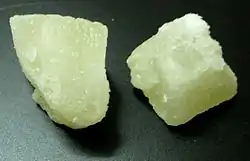
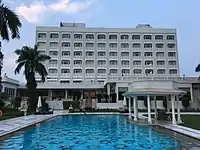
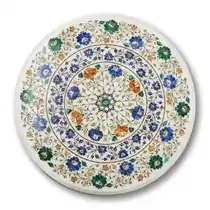
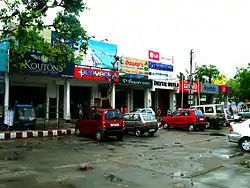

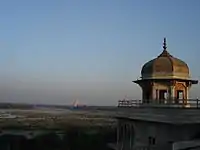
.jpg.webp)
